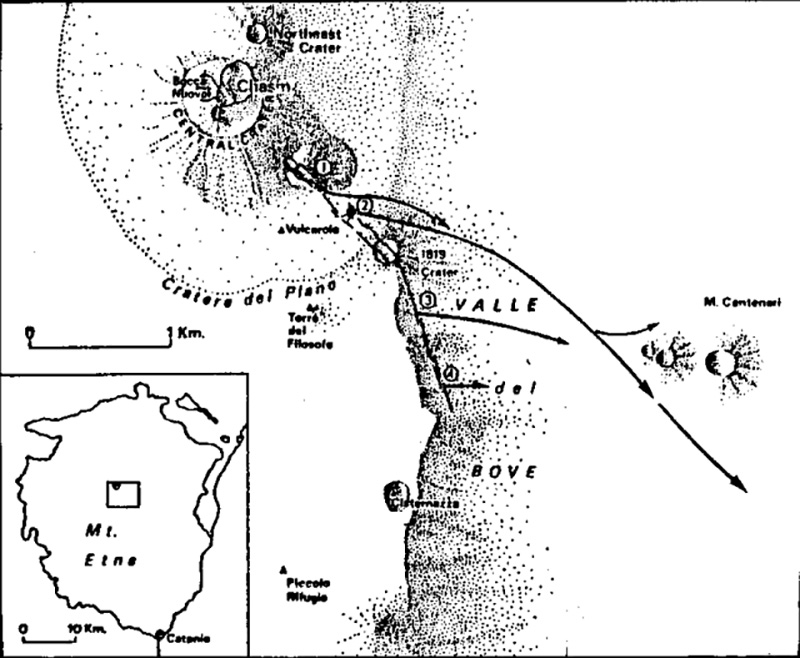Report on Etna (Italy) — May 1978
Scientific Event Alert Network Bulletin, vol. 3, no. 5 (May 1978)
Managing Editor: David Squires.
Etna (Italy) SE-flank eruption continues through May
Please cite this report as:
Global Volcanism Program, 1978. Report on Etna (Italy) (Squires, D., ed.). Scientific Event Alert Network Bulletin, 3:5. Smithsonian Institution. https://doi.org/10.5479/si.GVP.SEAN197805-211060
Etna
Italy
37.748°N, 14.999°E; summit elev. 3357 m
All times are local (unless otherwise noted)
R. Romano reported the eruption started on 29 April at about 2000-2030 from bocca 1 (figure 5). Explosive activity built a cone that was 50 m high by 2 May. Lava flowed from the E side of the cone into the Valle del Bovee. Fissures opened, extending into the 1819 crater, where they intersected another fissure set which runs along the wall of the Valle del Bove.
"During the afternoon of 1 May new boccas 2 and 3 opened on the existing fissures, then early the next afternoon bocca 4 opened, emitting a small lava flow that stopped the same day. Activity at bocca 1 also ended on 2 May, but the main flow front advanced at 100 m/hour. Bocca 3's activity diminished 6 May and ended by 7 May."
John Guest and J.B. Murray arrived at the volcano on 10 May and reported: "Lava effusion was limited to bocca 2, marked by a hornito 10 m high. The rate of eruption was 10 m3/s through midday 13 May when bomb ejection began at a rate that increased to 40-50 m3/s, but decreased to 20-30 m3/s by the next day and had returned to 10 m3/s by 15 May.
"Although bocca 1 was not emitting lava during this period, there were several collapses in the vent, producing billowing brown smoke. Occasional big explosions began 14 May, throwing bombs as much as 100 m above the vent. Explosions intensified on 27 May, but activity quickly returned to the 15 May level, and the eruption was continuing on 31 May.
"These eruptions have completely changed the Northeast Crater and surrounding area; the highest point on the volcano is now the Northeast Crater. Strong explosive activity during several eruptions has covered much of the summit area with ash, and during the Easter eruptions (March 25-28) there was a light ashfall as far away as Catania (25 km SE). Lava flows were extensive, one reaching as far down as 1,700 m elevation of the NW flank."
Geological Summary. Mount Etna, towering above Catania on the island of Sicily, has one of the world's longest documented records of volcanism, dating back to 1500 BCE. Historical lava flows of basaltic composition cover much of the surface of this massive volcano, whose edifice is the highest and most voluminous in Italy. The Mongibello stratovolcano, truncated by several small calderas, was constructed during the late Pleistocene and Holocene over an older shield volcano. The most prominent morphological feature of Etna is the Valle del Bove, a 5 x 10 km caldera open to the east. Two styles of eruptive activity typically occur, sometimes simultaneously. Persistent explosive eruptions, sometimes with minor lava emissions, take place from one or more summit craters. Flank vents, typically with higher effusion rates, are less frequently active and originate from fissures that open progressively downward from near the summit (usually accompanied by Strombolian eruptions at the upper end). Cinder cones are commonly constructed over the vents of lower-flank lava flows. Lava flows extend to the foot of the volcano on all sides and have reached the sea over a broad area on the SE flank.
Information Contacts: R. Romano, IIV; J. Guest, Univ. of London.


